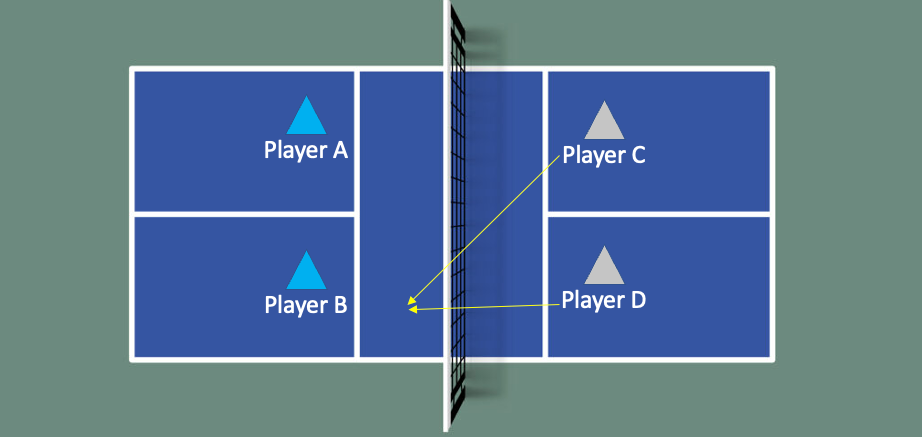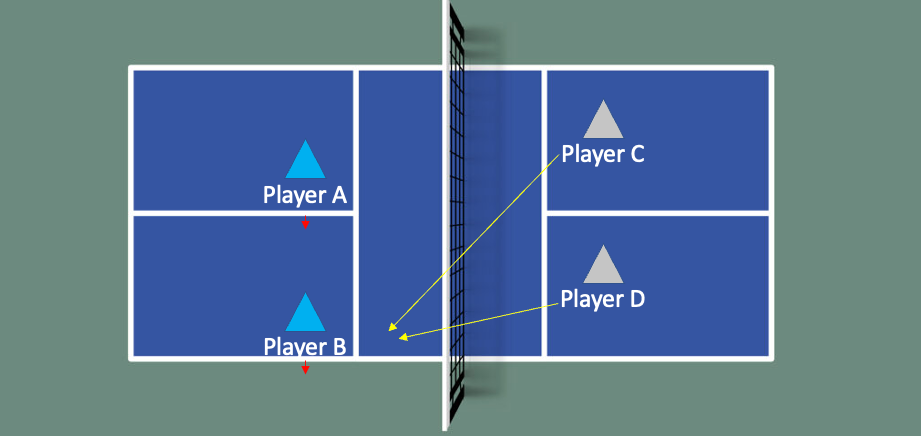
At a certain level, targeting is inevitable in pickleball. In fact, if you aren't incorporating some sort of targeting into your offensive strategy, you're doing yourself a disservice.
It's not as common in rec play, but it's almost inevitable in competitive play. Targeting is the repetition of deliberately hitting the pickleball to the weaker player, and avoiding the more dominant or skillful player.
It's most common in mixed doubles, even at the highest levels. The ball is repeatedly, and sometimes mercilessly, hit to the same player over and over again. And frankly, it's a great strategy. Why play the ball to the more skilled opponent?
But sometimes you find yourself on the other end of the strategy. Either you or your partner is being targeted, and to make matters worse, it's working...and you're losing.
So what do you do? You squeeze.
Let me state up front that someone is going to sustain a bruised ego. But it's a small price to pay for sweet sweet victory.
Scenario
Players C & D are targeting player B, and avoiding player A at the kitchen.

By maintaining a 50/50 position on the court, players AB are allowing CD to execute their game plan with ease.
To combat this, AB should shift to their right.

Player A is now responsible for 75% or more of the court. Player B's duty becomes hitting consistent shots back, typically cross-court to player C.
By shifting, AB have reduced the amount of space that CD can hit the ball to. They've made the target smaller. CD now have to be more accurate with their shots to continue to target B. This increases the chance for errors, and decreases their comfort level.
A few things can happen. If they hang one up near the middle, Player A is able to get aggressive, reach in and initiate an attack. The risk of Player A getting a paddle on the ball adds an extra layer of pressure to each of CD's shots. They feel constrained.
If they continue to try and target B, they risk the unforced error of playing the ball too wide, which could either go out, or set up an ATP for Player B.
The dynamic on the court has shifted. Now, players AB are waiting for their moment to pounce.
The mounting pressure will likely cause CD to play a ball back cross-court to stretch Player A out wide. This will open the game back up, and level the playing field. If CD opts for the middle, AB can dictate where the ball goes next.
You've successfully combatted the targeting. Understand that this pattern might repeat itself. CD targets B, AB squeezes, the game opens up, and then it repeats.
AB can opt to squeeze the get-go, allowing for A (presumably the dominant player) to play the 75% role the entire match. This is reminiscent of the Ben/Collin Johns strategy.
But to put a bow on this: if your weaker player is being targeted and you aren't at least occasionally cycling through a squeeze, then you're allowing your opponent to have their way.
If you are B in this scenario, then it's up to you to recognize this, shelf your ego, and allow your partner to assume a higher percentage of court. If your partner is targeted, good luck...hopefully they understand that you are just trying to win the game.
Squeeze baby, squeeze!

Love Pickleball? Join 100k+ readers for free weekly tips, news & gear deals.
Subscribe to The DinkGet 15% off pickleball gear at Midwest Raquet Sports









